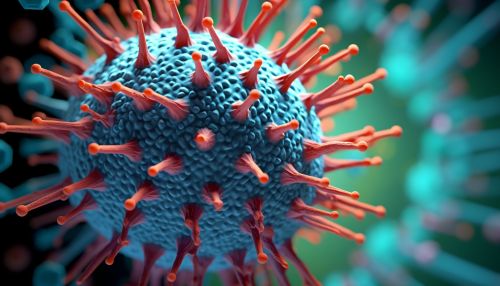Influenza A virus
Overview
Influenza A is a species of virus in the genus Influenzavirus A which is responsible for causing influenza in birds and some mammals. It is a highly mutable virus and is known for its zoonotic potential, meaning it can be transmitted from animals to humans. The virus is characterized by its two main surface proteins, hemagglutinin and neuraminidase, which are key factors in the immune response to infection.


Structure and Composition
The Influenza A virus is an enveloped virus, meaning it has a lipid bilayer derived from the host cell membrane. Inside the envelope, the virus contains eight segments of negative-sense, single-stranded RNA. Each RNA segment is associated with viral RNA-dependent RNA polymerase and multiple copies of the nucleoprotein, forming a viral ribonucleoprotein (vRNP) complex. The envelope of the virus is studded with two types of spikes made up of the surface proteins hemagglutinin and neuraminidase.
Classification
Influenza A viruses are classified based on the type of hemagglutinin and neuraminidase they possess. There are 18 known H subtypes and 11 known N subtypes. However, only H1N1 and H3N2 are currently in widespread circulation in humans. Other subtypes, such as H5N1, H7N9 and H1N2, have caused human infections and pose potential pandemic threats.
Replication Cycle
The replication cycle of the Influenza A virus begins with the binding of the hemagglutinin on the virus to sialic acid receptors on the surface of a host epithelial cell. This is followed by endocytosis of the virus particle into the host cell. Inside the cell, the viral RNA segments are released and transported into the nucleus where transcription and replication occur. The newly synthesized viral proteins and RNA are then assembled into new virus particles which are released from the cell by budding.
Pathogenesis and Immunity
Influenza A virus primarily infects the respiratory tract and causes symptoms such as fever, cough, sore throat, and muscle aches. The severity of the disease can range from mild to severe and can sometimes lead to complications like pneumonia. The immune response to the virus involves both the innate and adaptive immune systems. Antibodies against the hemagglutinin and neuraminidase proteins provide protection against reinfection with the same strain of the virus.
Epidemiology
Influenza A viruses can infect a range of hosts including humans, birds, pigs, horses, and seals. The virus can also cross species barriers and cause zoonotic infections. The ability of the virus to mutate and reassort its genome allows it to evade the immune system and is responsible for the periodic epidemics and pandemics of influenza.
Prevention and Control
Vaccination is the most effective method for preventing influenza A virus infection. Antiviral drugs like oseltamivir and zanamivir can also be used for treatment and prophylaxis of influenza. In addition, surveillance of circulating influenza viruses and rapid identification of new strains is crucial for the control of influenza epidemics and pandemics.
